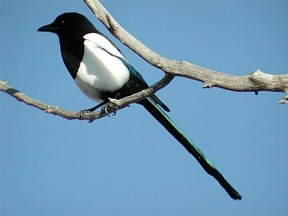|

Large, noisy jay, mostly black, with very long tail and
dark, stout bill. Wings and tail are iridescent blue and green-black.
White belly and sides. Eats insects, larvae, carrion. Direct flight
on shallow, steady wing beats. Often glides between perches or from
perch to ground.

|
BLACK-BILLED
MAGPIE
Pica pica
PASSERIFORMES
Crows and Jays (Corvidae)
Range and Habitat
Resident from Alaska and western Canada south to California and the
Great Plains. Preferred habitats include open woodlands, savannas, brush-covered
country, and stream sides.
SOUND: "mag-mag-mag", "yak-yak-yak"
The Black-billed Magpie spends up to 40 hours building nests with domes
on top. In the past, they have been considered vermin (due to their
feeding on poultry eggs and orchard crops) and farmers have placed bounties
on them.
They are now protected in the U.S.
Unlike most birds, they can use scent to locate food.
A group of magpies has many collective nouns, including a "charm",
"gulp", "mischief", "tittering", and "tribe"
of magpies.
The Black-billed Magpie is part of the crow family, and inhabits western
North America and southern Alaska.
This species is one of the few in which mates stay
together for life. They nest at the tops of evergreens and other deciduous
trees, and are mainly non-migratory. At times, the Black-billed Magpie
will travel south or east during winter months, but they typically form
colonies and roost together during this time of year. The Black-billed
Magpie is omnivorous, dining on berries, insects, carrion, eggs and
rodents. Populations are so dense that the conservation status for this
species is rated as Least Concern.

|